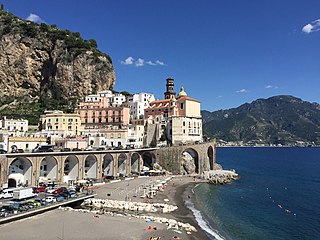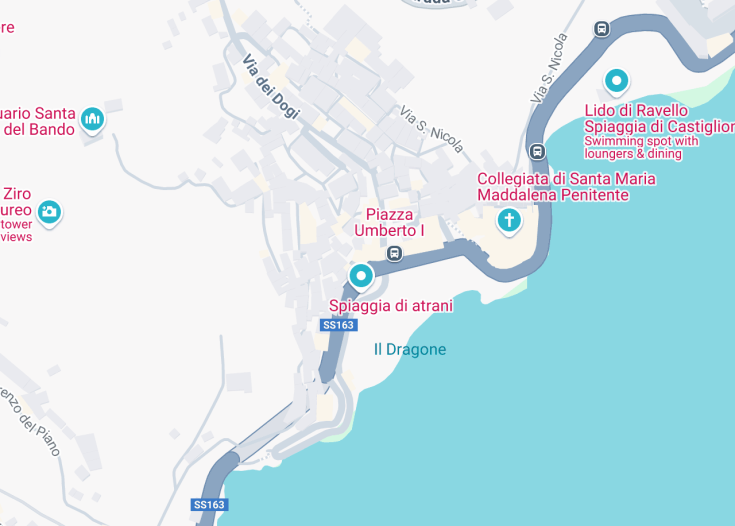Nestled on the Amalfi Coast, Atrani, Italy, emerges as a charming enclave largely untouched by the commercialism that characterizes many of Italy’s seaside destinations. This picturesque village offers a serene retreat with its compact design, scenic beach, and historic architecture, including the Church of San Salvatore de’ Birecto. Atrani’s intimate scale and preserved cultural heritage invite visitors to experience a more authentic slice of Italian coastal life, making it an ideal escape for those seeking tranquility and a deep dive into rich history and tradition.
For an enchanting experience, visit Atrani during the evening to witness the stunning sunset over the Mediterranean, casting a golden glow on the village.
Consider exploring the narrow, winding streets of Atrani to discover hidden local eateries where you can savor traditional Italian dishes.
Top things to do & see in Atrani
Select the following sights and activities to discover best tickets and tours available in Atrani.
Atrani: Italy’s Coastal Gem
| Country | Italy |
| Time in Atrani | GMT+1 |
| Language spoken | Italian |
| Population | 921 (source: latest municipal census data) |
| Currency | Euro (€, EUR) |
| Airports |
|
Atrani, located on the Amalfi Coast of Italy, enchants visitors with its scenic beauty and historic charm. This picturesque town, with its compact grid of pedestrian streets and alleyways, embodies the essence of a Mediterranean seaside village. Despite being one of the smallest towns in Italy, Atrani offers a rich history and a vibrant local culture.
Historically, Atrani was the residence of the most powerful Amalfi families who built their houses around the town square and St. Maria Maddalena church, notable for its beautiful Baroque facade and majolica-tiled dome. The town’s architecture is characterized by intricate passageways, arches, and courtyards, remnants of a prosperous past during the Maritime Republic of Amalfi.
Today, Atrani maintains its ancient fisherman village vibe with locals often seen enjoying the central piazza and engaging in traditional crafts. The beach at Atrani, though small, is perfectly nestled between cliffside and sea, offering a tranquil escape from the more crowded neighboring towns. Culinary enthusiasts will enjoy authentic Southern Italian cuisine at quaint restaurants overlooking the pristine waters of the Tyrrhenian Sea.
Aside from leisure and cuisine, Atrani’s geographical configuration makes it an excellent spot for coastal hikes and exploring the natural landscapes of the Amalfi coast. The town’s proximity to popular tourist destinations like Amalfi and Ravello also makes it a convenient base for exploring the region’s historical and cultural sights.
Cultural activities in Atrani include the celebration of patron saints during the Festival of Santa Maria Maddalena on July 22nd, featuring a procession, fireworks, and musical performances, drawing both locals and tourists alike. Atrani’s untouched charm, devoid of mass tourism, offers a unique glimpse into the life on the Amalfi Coast and continues to captivate those who visit this enchanting village.
Where is Atrani?
Atrani is nestled along the scenic Amalfi Coast in the Campania region of southern Italy, bordered by the Tyrrhenian Sea and dramatic limestone cliffs.
Distances:
| Route | Distance by car | Time by car |
|---|---|---|
| From Rome to Atrani | 173 miles (278 km) | 3 hours 30 minutes |
| From Naples to Atrani | 37 miles (60 km) | 1 hour 10 minutes |
| From Salerno to Atrani | 16 miles (26 km) | 35 minutes |
What is Atrani famous for?
Atrani is renowned for its unspoiled and picturesque village landscape, historic architecture, and its status as one of the Amalfi Coast’s most tranquil spots, offering an authentic slice of Italian coastal life.
History
Prehistoric Period to Middle Ages
Atrani, located on Italy’s beautiful Amalfi Coast, has a history that is both rich and intricate, weaving through periods of prosperity and obscurity. The earliest occupants of the area, dating back to the prehistoric period, were likely attracted by its favorable coastal position and natural resources. Over the centuries, Atrani grew into a vibrant maritime village, playing a key role in the maritime power of the Duchy of Amalfi in the medieval period. By the 10th century, Atrani was fully established, benefiting from the burgeoning trade routes across the Mediterranean.
10th Century to Renaissance
During the Middle Ages, Atrani reached its peak of influence. The town was home to aristocrats and artists, and its architecture flourished with elaborate churches and noble houses that still stand today. In 1135, Atrani was briefly taken over by the forces of Pisa, but it soon regained its independence, continuing to prosper as a key trading point on the Amalfi Coast. This period saw the construction of the Saint Salvatore de Birecto Church, which played a significant role in the inauguration ceremonies for the Duchy of Amalfi’s magistrates.
17th Century to Modern Day
The decline of the Duchy and a series of natural disasters in later centuries led to a gradual decline in Atrani’s prominence. However, the village’s cultural and historical heritage remained intact, preserving its medieval street plan and historic buildings. In the modern era, Atrani has been rediscovered as a tourist destination, appreciated for its authenticity and untouched charm compared to more commercialized neighbors. Despite its small size, Atrani’s unique history continues to captivate visitors and historians alike, offering a vivid glimpse into the past along the Amalfi Coast.
Visit Atrani
What to see and do in Atrani
Atrani offers a plethora of activities and sights that showcase its historic and cultural significance. Not to be missed is the Collegiate Church of Santa Maria Maddalena, recognized for its baroque architecture and stunning location overlooking the sea. Strolling through Atrani’s narrow alleys and climbing its stepped streets provides not only a physical workout but also a sensory experience, with white houses draped in bright bougainvillea and the sound of the waves in the background.
- Explore Piazza Umberto I, the town’s main square.
- Visit the Church of San Salvatore de Birecto, steeped in the history of noble ceremonies.
- Check out the events at the square, especially during summer.
- Relax on Atrani’s small beach, a less crowded alternative to its neighbor, Amalfi.
Events in Atrani
Atrani hosts several cultural and traditional events throughout the year that are rooted in its rich history. Most notable are the festivities for the patron saint, Saint Mary Magdalene, celebrated on July 22nd with a grand festival that includes a procession, fireworks, and musical performances. Additionally, the Christmas period offers unique celebrations, including live nativity scenes set against the picturesque backdrop of the town’s ancient architecture.
Best time to visit Atrani
The best times to visit Atrani are during the late spring (April to June) and early autumn (September to October). During these periods, the weather is pleasantly warm, and the town is less crowded than in the peak summer months. This allows for a more relaxed exploration of its historic sites and beautiful landscapes.
Is Atrani worth visiting?
Atrani is undoubtedly worth visiting for those who appreciate the charm of a quiet, historic coastal town. This hidden gem on the Amalfi Coast offers a rare glimpse into the authentic Italian lifestyle, away from the hustle and bustle of more frequented tourist spots. Its well-preserved medieval architecture, vibrant cultural scene, and stunning natural beauty make Atrani a must-visit destination for those seeking a deeper connection with Italian history and culture.










